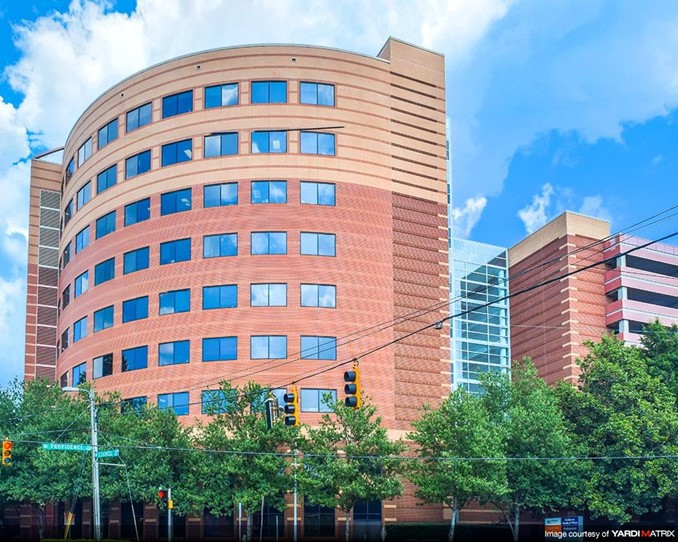Sources say that CNL Healthcare Properties is considering a sale of its 54 MOBs
Name: CNL MOB Portfolio
Number of buildings: 54
Square feet: 3.26 million
Locations: 17 states
Seller: CNL Healthcare Properties
Investment in the MOBs: $931.4 million

The the CNL Healthcare Properties portfolio includes the 218,489 square foot Midtown Medical Plaza in Charlotte, N.C. (Photo courtesy of CNL)
Last year, we at Healthcare Real Estate Insights™ – and others – declared 2017 to be the year of the medical office building (MOB) portfolio. We might have been a bit premature, as it looks as if 2018 might be even more deserving of that title – at least based on what we’ve seen so far.
Our two most recent previous Hot Property features have highlighted portfolios that will undoubtedly sell for hundreds of millions of dollars. Another portfolio on the market that was not featured as a Hot Property could garner a similar price.
And now, in recent weeks we’ve heard about another possible portfolio that could hit the market in coming weeks or months that is likely to fetch a similar amount, perhaps even more than $1 billion.
However, this time we’re not 100 percent positive that this Hot Property will actually hit the market. And although we at HREI™ are extremely cautious about sharing unconfirmed reports, we have it on good authority from multiple sources that this potential portfolio sale is imminent – and it’s just too big to ignore.
We have heard from reliable sources that Orlando, Fla.-based CNL Healthcare Properties is considering an exit strategy for the 54 MOBs that it accumulated during the course of several years, starting in 2012. Sources tell us that CNL has hired a team with Pittsburgh-based HFF Inc. (NYSE: HF) and Cleveland-based KeyBank to look at strategic alternatives for the portfolio, which could include marketing it for a potential sale.
HREI™ reached out to several CNL executives for comment, but they had not responded by the time this edition of HREI™ went to press.
CNL Healthcare Properties, a non-traded real estate investment trust (REIT) sponsored by CNL Financial Group LLC, is said to be looking into the possible sale of its MOBs, which comprise about 31 percent of its overall healthcare portfolio based on valuation. As of the end of May, according to a fact sheet on CNL’s website, the non-traded REIT’s overall portfolio included 72 seniors housing communities, 54 MOBs, 12 post-acute care facilities and five acute-care hospitals. CNL invested a total of $3.02 billion into the facilities – both through acquisitions and development – including $931.4 million into its MOBs.
CNL Healthcare Properties, which closed to investors on Sept. 30, 2015, is not to be confused with CNL Healthcare Properties II, which was launched in 2016 and is still open to new investors.
According to its prospectus, CNL Healthcare Properties developed and acquired properties with a total investment of about $3.02 billion from 2012 to 2015. The REIT consists of 58 percent senior housing, 31 percent MOBs, 6 percent post-acute and 5 percent acute care facilities, based on purchase price, development budget and/or capitalized cost.
As noted above, the total investment amount for the MOBs was $931.4 million, according to the prospectus, which would almost certainly mean they would fetch more than $1 billion thanks to appreciation, especially if they were sold in a competitive bidding situation.
The REIT’s largest MOB acquisition closed in late 2014, when it acquired a portfolio of nine “Class A” facilities in the Southeast for about $238 million. The MOBs in the CNL portfolio that have the greatest valuation include: Midtown Medical Plaza, Charlotte, N.C., $54.7 million; Presbyterian Medical Tower, Charlotte, N.C., $36.3 million; Bend Memorial Clinic MOB, Bend, Ore., $36 million; and Center One, Jacksonville, Fla., $34.4 million.
It is not uncommon for private REITs to consider their strategic alternatives, including liquidity events, when they have achieved their acquisition objectives or at least reached a certain critical mass. Those alternatives can include going public and being listed on a national exchange; selling a fund or the whole company as an entity to another investor or party; merging with another company or entity; or engaging in another transaction with a third party or parties that would provide shareholders with cash and/or securities of a publicly traded company.
– Murray W. Wolf
The full content of this article is only available to paid subscribers. If you are an active subscriber, please log in. To subscribe, please click here: SUBSCRIBE






